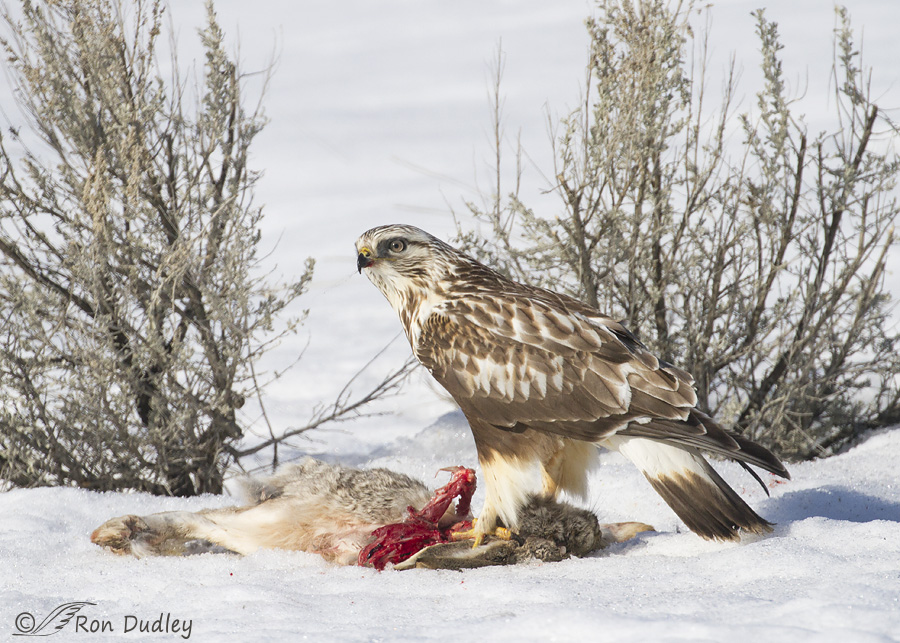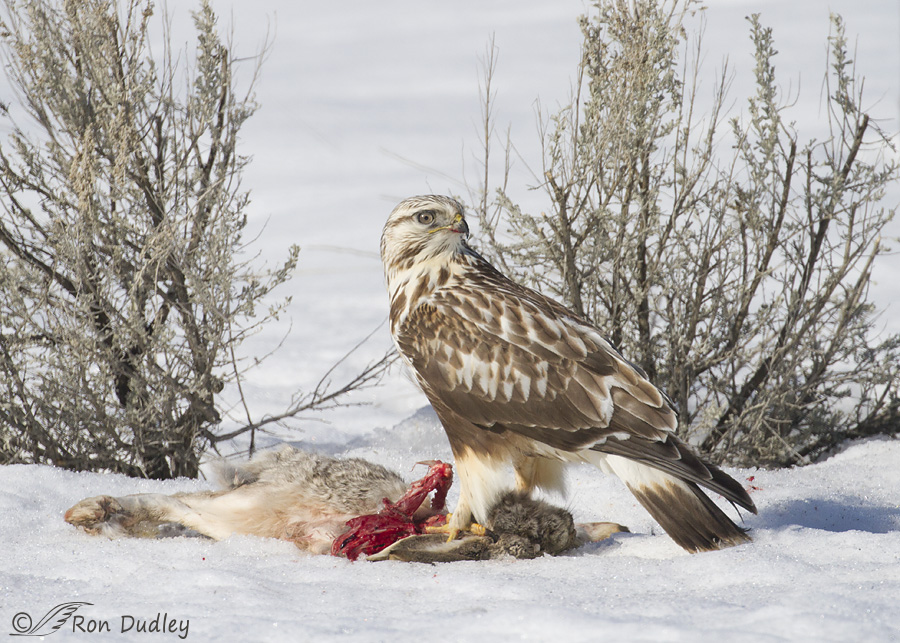I carry a second camera and lens combo with me whenever I’m in the field. Yesterday it paid off handsomely.
When we found this Rough-legged Hawk on a rabbit kill yesterday morning in Box Elder County I didn’t have the opportunity (for complicated reasons) to maneuver my pickup into an appropriate distance from them for the lens I was using. I was simply too close for my 500mm lens (probably even with the teleconverter removed). So I reached over the seat and grabbed my shorter zoom lens with another camera body attached and the bird gave me only a few seconds with it before it took off.
Without the spare body and lens all I’d have is a few images that were too tight on the hawk and rabbit – if I was lucky. If I wasn’t lucky the hawk would have flown off by the time I got my tc removed and the camera reattached to the lens.
1/5000, f/5.6, ISO 400, Canon 7D, Canon EF 100-400mm f/4.5-5.6L IS II USM @ 400mm, not baited, set up or called in
This is one of the few shots I got before the hawk lifted off. Some folks don’t appreciate photos that include partially eaten prey but for me these images epitomize raw nature in a wild and natural setting. They aren’t too gory for my tastes and I appreciate the entire scene with good light on both bird and rabbit, both of them positioned between the two sagebrush, excellent exposure on the snow and enough depth of field to get both bird and prey sharp (even though my camera settings aren’t ideal for the situation).
And I had enough room in the image to crop to a composition that pleases me.
1/5000, f/5.6, ISO 400, Canon 7D, Canon EF 100-400mm f/4.5-5.6L IS II USM @ 400mm, not baited, set up or called in
The hawk never did give me much pose variety but when it turned its head to this angle it put better light on the face so this is my favorite image of the two.
I’m unsure if the rabbit was road kill or prey killed by this hawk or another raptor (both eagle species and Red-tailed Hawks are common in the area). The rabbit was perhaps 15′ off the road (how did it get that far off the road if it was road kill?) in deep snow and it didn’t look mangled like most road kill so I suspect it may have been killed as prey. Rough-legged Hawks normally prefer live prey but they will feed on carrion when the ground is snow-covered which makes their preferred prey less available. And roughies are known to kill rabbits but the only documentation I could find of them doing so was with rabbit prey that is young and/or small (tundra or snowshoe hares).
From Birds of North America Online: “Rabbits can be important winter food, primarily as carrion, and particularly after snow when small mammals are less available”.
Prey or road kill, I’m glad I had my spare camera and lens along on this trip.
Ron




As always, wonderful images and information, Ron. With respect to predator-prey interactions, I actually have a tougher time photographing/posting live prey shots because I feel as though I’m capturing a sentient being’s last moments. It’s a personal thing, you know me. As far as the rabbit’s unfortunate fate, it is possible he or she suffered a car-related trauma, like head injury, but was still able to scramble those 15 feet before dying. I’ve seen that happen in a couple of cases where I witnessed a car striking an animal, and then followed the animal into the scrub to see if I could provide a rescue assist.
As far as the rabbit’s unfortunate fate, it is possible he or she suffered a car-related trauma, like head injury, but was still able to scramble those 15 feet before dying. I’ve seen that happen in a couple of cases where I witnessed a car striking an animal, and then followed the animal into the scrub to see if I could provide a rescue assist.
Great photo, you did better then we did yesterday. The birds were all very jumpy. We saw juvenile Bale Eagles, many Roughies and Kestrels but only the cows were cooperative subjects. It was nice to see all the water in the Great Salt Lake and the blue sky.
Wonderful shots! Sharp, and the red actually gives the scene a color focal point. You’re so right about that extra camera/lens availability. More than once I’ve been caught with a big long lens that cuts off half the subject. Great post!
Kath, there aren’t many things worse than an otherwise spectacular shot that’s much too tight!
Ron,
I am looking to upgrade and have only been looking at the 7d mark ii. Now I see what you shot with the 7d. The photos with the 7d are great. It seems that your progression was from the 40d to the 7d and now one or two of the 7d mark ii’s. I shoot 99.9% wildlife/nature, plus jr. high track meets.
What might be the advantage of the 7d mark ii over the 7d.
I have the 40d, my second one. Does the 7d auto focus using a the 1.4 tc? Have you used the video option in the mark ii?
Keep up with photo geek tech stuff.
jake schas
Jake, there are several advancements of the Mark II over the 7D but for me the most important ones are a faster burst rate and a buffer that doesn’t fill so quickly. I’ve loved my 7D’s but now that I have the Mark II I sure wouldn’t want to go back. But then I shoot mostly birds and for them those two features are invaluable.
The 7D will AF with the 1.4 tc if you’re using a lens at least as fast as F/4 – slower than that and it won’t. The Mark II + tc will AF with my 100-400 but only to f/8.
As good as it gets, Ron.
Thank you, Neil.
As you know, I always feel sorry for the victim/the prey( unless it’s a politician or a a snake…hard to tell the difference sometimes )but am glad to see the birds find food…Mother Nature and I don’t always see eye to eye…even so, I respect her wishes….
“Mother Nature and I don’t always see eye to eye…even so, I respect her wishes….”
I like the way you said that, Patty – very much.
I’m also glad you had your spare camera. The positive thing about seeing a bird with prey, even if there is blood in the picture, is that the bird is eating and therefore surviving. I also think it’s good for us to see the reality of nature; our human life style is very far removed from that these days. This is one gorgeous Hawk.
“I also think it’s good for us to see the reality of nature”
As do I, Susan – very much so.
Gorgeous shots! I am listening to Helen Macdonald’s H is for Hawk. Part of it is about her training a goshawk and its behavior while hunting. Lot of other stuff in the book, TH White and her grief over her father’s sudden death. Interesting story.
I keep meaning to read that book, Jo. Thanks for the reminder.
Like your shots. A predator on prey depicts nature. It’s the pics of birds wrapped up in “Devil” wire that get to me! I still can see that image you took of the short eared owl twisted up in that strand of barbed wire some months back. Thank’s to you and Mia the outcome was far better than it could have been. My hat’s off to you guys.
Bill, I see that poor owl entangled in barbed wire in my mind much more often than I want to. Don’t think I’ll ever forget it…
These are excellent shots Ron. I particularly appreciate it when you show nature as nature is! These shots are important, at least to me, because they prove how a small rodent predator survives during hard times. I tend to favor what the Birds of North America Online said what could be a Roughy’s food source during conditions you supplied. Wonderful shots!
“I particularly appreciate it when you show nature as nature is!”
That’s my goal for almost all of my shots, Dick. Thanks.
Exactamundo!
Are you still shooting with your old trambone 1-400 or did you get a new one?? The pictures are great….
Thanks, Marina. I bought the new version of the 100-400 very soon after it came out.
Love it!! Rabbit actually makes it special. And so does the snow and brush . I’m not a fan of tight crops .. I love seeing the birds in they’re environment.. so judges who tell me to crop tighter I simply ignore… gorgeous pictures Ron!!!!!
Like the great teacher you are — always have a “Plan B” in your back pocket.
These are fabulous photos! The composition is stupendous. Nature in the raw, indeed.
Marty, Plan B has saved my bacon more than once. I love having both sets of gear with me (plus a third combo for spontaneous documentary and landscape shots…).
Hi Ron,
Those are incredible shots. Are you sure they aren’t a taxidermy set up??
Pretty sure, Len…
Wonderful shots Ron!
charlotte
Thanks, Charlotte.
Its always good to grab the shots like that, never know when some details shows up later that reveals a new bit of knowledge.
Yup.
Gorgeous photo’s, Ron – great detail of the hawk and prey Sure paid off having the extra shorter lens/camera body in this case! That’s the problem with “long lenses”.
Sure paid off having the extra shorter lens/camera body in this case! That’s the problem with “long lenses”.
It sure paid off this time, Judy. The one time I don’t have that other camera and lens will undoubtedly be the time I need it.
AWESOME!
Thanks, Marie.
I do aappreciate seeing nature in the raw. It is not Disney most times and gives so much context to the life of the creatures.
I appreciate that feedback, Donna. Thanks.